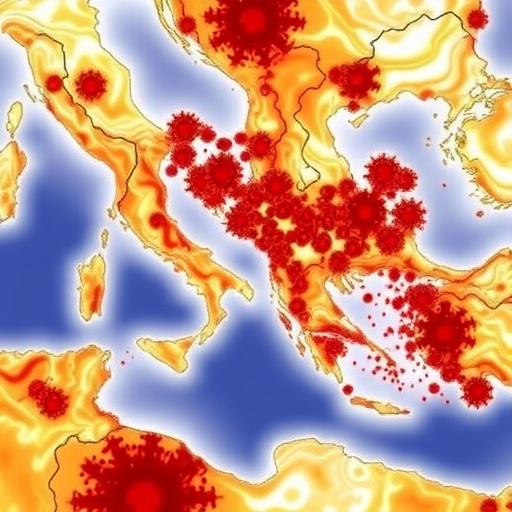A groundbreaking study led by the Institut de Ciències del Mar (ICM-CSIC) has unveiled a persistent and unprecedented decline in the abundance of marine viruses in the northwestern Mediterranean Sea over the past two decades. This remarkable discovery, published in the journal ISME Communications, stems from the longest continuous dataset ever recorded on marine viral populations, sourced from the Blanes Bay Microbial Observatory (BBMO) in Girona. The implications of this trend extend far beyond microbiology, shedding light on how global climate change is reshaping oceanic ecosystems at the smallest scales.
Since 2011, data reveal a steady decrease in marine viral abundance, coinciding with rising seawater temperatures and an increase in water transparency. Simultaneously, there has been a conspicuous reduction in nutrient levels and phytoplankton biomass. Collectively, these changes indicate a process known as oligotrophication—a gradual impoverishment in nutrient availability—that drives the ecosystem towards a less productive, more pristine state. Such biochemical shifts not only influence microbial life but also have cascading effects on higher trophic levels and biogeochemical cycles within the Mediterranean basin.
Marine viruses, though invisible to the naked eye, are pivotal players in oceanic ecosystems. They regulate microbial populations through lysis, which controls the abundance of bacteria and phytoplankton, thereby affecting nutrient recycling and the flow of organic carbon. Viral lysis promotes the release of cellular contents back into the environment, facilitating nutrient turnover and microbial loop efficiency. Moreover, viruses can directly influence carbon sequestration by promoting the sinking of organic particles to the ocean floor, an essential mechanism in the global carbon cycle and climate regulation.
The BBMO, established in 2001, represents one of the world’s most comprehensive and long-standing microbial observatories, providing unparalleled monthly surface water samples. This extensive dataset captures the nuanced dynamics of viruses, microbial communities, and environmental conditions across two decades, making it uniquely suited to analyze long-term trends rather than short-term fluctuations. Its high-resolution temporal data offer insights into how microbial ecosystems respond to environmental pressures over extended periods.
Advanced statistical modeling, including Generalized Additive Mixed Models (GAMMs), has enabled researchers to dissect seasonal variability and discern subtle long-term changes amidst complex environmental fluctuations. Additionally, the application of machine learning techniques, particularly neural network models, has facilitated the unraveling of intricate interactions between viral populations and their environmental parameters. This convergence of statistical rigor and artificial intelligence has been critical in identifying hidden patterns and decoupling transient perturbations from enduring ecological shifts.
The sustained decline in marine viruses aligns closely with increased surface water temperatures, underscoring the profound impact of climate warming on microbial ecology. As ocean temperatures rise, metabolic rates of microorganisms alter, and stratification limits nutrient upwelling, further exacerbating oligotrophic conditions. This scenario reduces productivity at the base of the food web, ultimately influencing higher organisms, from zooplankton to commercially valuable fish species. Consequently, the viral downturn might signal broader ecosystem destabilization.
Ecologically, a reduction in viral abundance can disrupt the fine balance of microbial population control and nutrient remineralization. Viruses modulate microbial diversity and prevent any single microbial species from dominating. A diminished viral presence could thus precipitate shifts in community composition, possibly favoring less efficient nutrient cycling pathways. This disruption threatens to decrease ocean primary productivity, with potential repercussions on fisheries and the socio-economic fabric of Mediterranean coastal communities reliant on marine resources.
Given that previous studies on marine viruses have largely been constrained to spatial gradients or brief temporal windows, the BBMO time series offers an unprecedented window into the cumulative effects of climate change on viral ecology. This long-term perspective allows scientists to differentiate natural ecological variability from anthropogenically induced trends. The unequivocal evidence of viral decline tied to oligotrophication highlights the silent but significant transformations occurring beneath the ocean’s surface, largely unnoticed by the broader public.
Looking ahead, the research team is embarking on genomic sequencing of viral samples collected throughout these years. This analysis aims to determine whether the reduction in viral abundance correlates with diminished genetic diversity within viral communities, which would have important implications for viral adaptability and ecosystem resilience. Such genomic insights will deepen our understanding of how viral evolution interacts with environmental stressors and reshape microbial ecosystem dynamics under climate change.
Furthermore, the consistency of these findings with other Mediterranean studies, albeit over shorter timescales, suggests that this pattern of viral decline and oligotrophication is widespread across the basin. This regional coherence emphasizes the pervasive influence of environmental change on microbial oceanography and the urgent need to incorporate microbial perspectives into climate change models and marine conservation strategies.
The study underscores the necessity of sustained, high-frequency microbial monitoring coupled with interdisciplinary analytical approaches. Harnessing the power of advanced statistical tools and artificial intelligence has proven indispensable for untangling the complex web of interactions that govern microbial ecosystems. Such integrative methodologies are crucial for predicting future trajectories of marine ecosystems in a warming world and for informing sustainable management policies.
In sum, the two-decade decline of marine viruses at a NW Mediterranean coastal site provides compelling evidence of how global warming and oligotrophication are fundamentally reshaping microbial communities. These changes, while microscopic in scale, bear monumental consequences for ocean health, carbon cycling, and human societies dependent on marine biodiversity. The BBMO initiative exemplifies how long-term ecological observatories serve as critical sentinels, revealing the invisible yet accelerating impacts of climate change beneath the ocean surface.
Subject of Research: Not applicable
Article Title: Long-term decline of marine viruses associated with warming and oligotrophication at a NW Mediterranean coastal site
News Publication Date: 29-Aug-2025
Web References: http://dx.doi.org/10.1093/ismeco/ycaf150
Image Credits: ICM-CSIC
Keywords: Abrupt climate change




